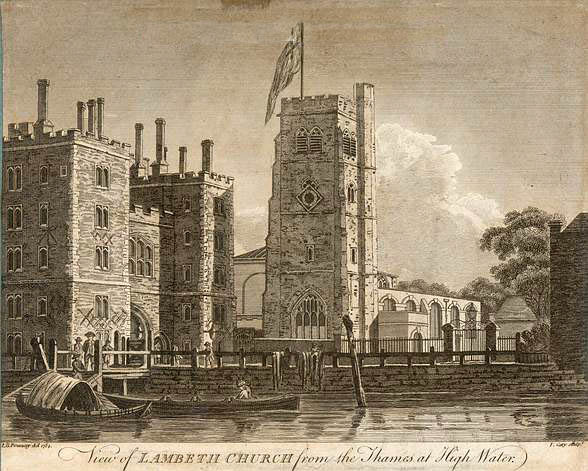


Lambeth Palace and St-Mary-at-Lambeth Church
Lambeth Palace is the official London Residence of the Archbishop of Canterbury. It has been in the possession of the Archbishops since about 1200.
Below is a map showing its location. On the map you can see the various points-of-view which can be seen in the the photographs on this web page.

The oldest parts of the present buildings date from the 1400's. The most obvious external feature is the gatehouse which is framed on either side by two towers, built by in tudor brick by Archbishop Morton in 1495. This is consequently known as Morton's Tower; below is how it looks today, view number 1:

Many Partleton weddings and christenings were performed in the neighbouring church which can be seen at the right of the above picture, the Church of St-Mary-at-Lambeth. There has been a church on this site since 1042.
The most obvious external surviving feature of St-Mary-at-Lambeth church is the best bit: the church tower which was completed in 1378. Most of the rest of the church is a Victorian rebuild of 1851.
Below we see St-Mary-at-Lambeth alongside the Morton Tower in 1784, view number 2:

This is the church in which Benjamin Thomas Partleton (1799-1843), House Painter, was married to Mary Greenwood in the year 1821. Lambeth at this time is still somewhat rural. There are windmills in the area.
The population of Lambeth rose from 28,000 in 1801 to 139,000 in 1851 and over 160,000 in 1861.
By the year 1863, when Benjamin's son Charles Greenwood Partleton (1842-1918) is married in the same church to Jane Ann Willcox, the tower remains, but the church had been heavily rebuilt in 1851, as can be seen in this nice photograph of 1860 (view number 3) which makes an interesting comparison with the previous view number 2 of 1784:

This is a good place to show three more photographs of the immediate area taken in 1864 by William Strudwick, a man who really knew how to take a picture:
The first photo is view number 4, looking south down Bishop's Walk, beautiful... step into their shoes:

At the left of the above photo we see the boundary wall of Lambeth Palace, which I believe is still there. Lambeth at this time is home to a lot of boat-building businesses, one of which, Searle's, can be seen in the advertising sign 'Boats Let & Housed'. All the houses on the right are long gone and the site to the right of the road is now part of St. Thomas' Hospital.
Moving a little further south, we come to the foreshore where the timber for boat building is stored - view number 5:

Continuing south, in the picture below, we are now standing outside St-Mary-at-Lambeth Church, looking across Church Street - view number 6, great picture. This general area is home to the vast majority of Partletons from 1820 to 1900 and this would be a view very familiar to all of them.

The building centre right in the above photo is Bunyan's Hall, latterly the 'Onward Working Men's Club'. Below, it is pictured shored up just before its demolition in 1883. 'Shaving' on offer in the shop window for a penny.

Here's something a bit different. A 3-dimensional view.

The trick is to relax, sit with your face about a foot from the screen and cross your eyes. The two images will resolve into a single picture in the middle, in 3-D. Give it a try - if you succeed, it really puts you there. Step into their shoes...
The earliest known image of Lambeth is in the famous woodblock map (1588) of London by surveyor Ralph Agas (1540-1621). We are in the middle of the reign of Queen Elizabeth I. There are no bridges over this part of the Thames, just lots of boats. Lambeth Palace and St-Mary-at-Lambeth Church are there, in the countryside, at the bottom right.

If you enjoyed reading this page, you are invited to 'Like' us on Facebook. Or click on the Twitter button and follow us, and we'll let you know whenever a new page is added to the Partleton Tree:
Do YOU know any more to add to this web page?... or would you like to discuss any of the history... or if you have any observations or comments... all information is always welcome so why not send us an email to partleton@yahoo.co.uk
Click here to return to the Partleton Tree 'In Their Shoes' Page.